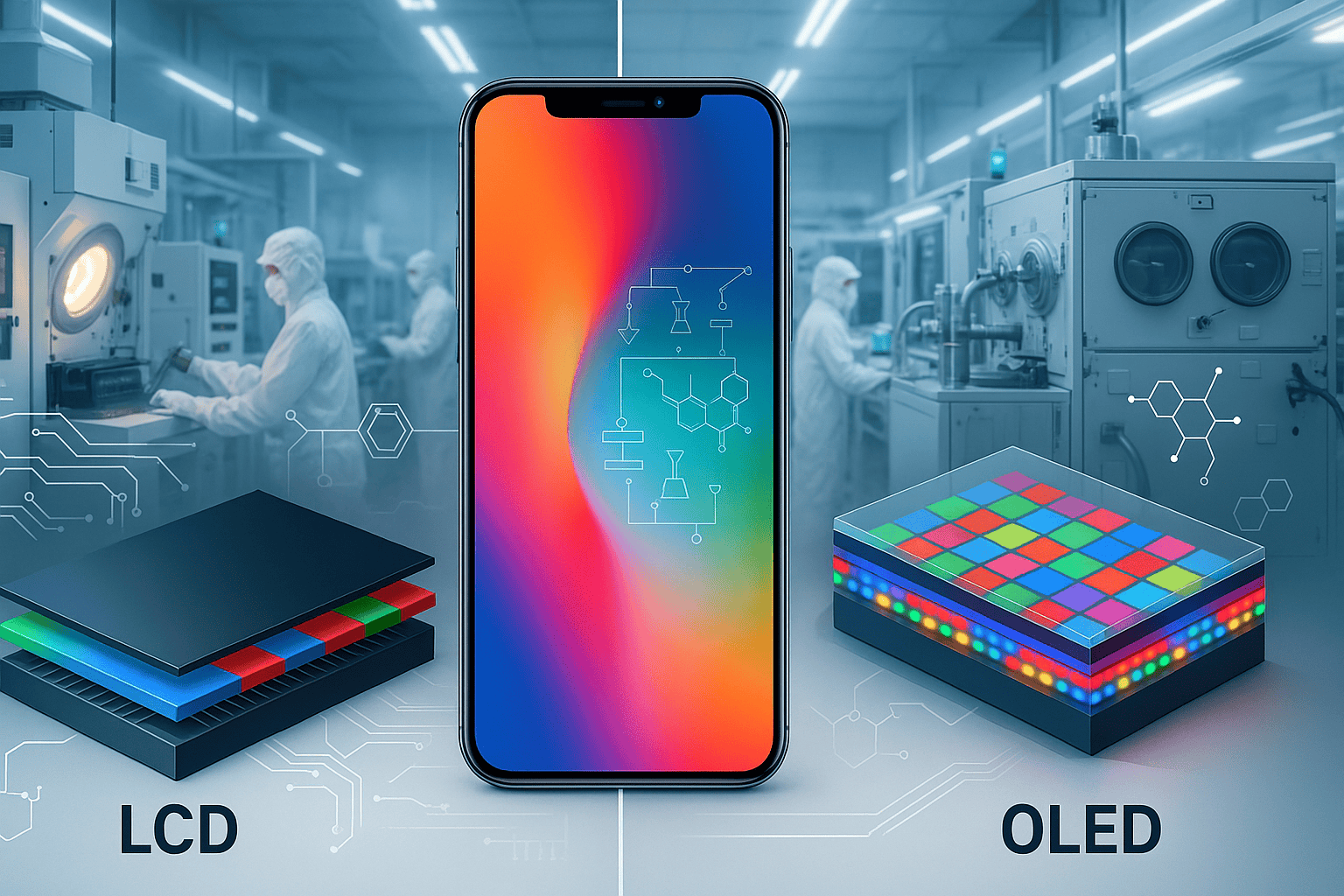OLED vs LCD: The Ultimate Technical Comparison Guide for Mobile Display Technologies
In today's rapidly evolving smartphone market, display technology has become one of the most critical factors determining user experience, device pricing, and market positioning. Two dominant technologies have emerged as the primary choices for mobile displays: OLED (Organic Light-Emitting Diode) and LCD (Liquid Crystal Display). These technologies differ fundamentally in their light emission principles, optical performance characteristics, power consumption patterns, lifespan expectations, and manufacturing costs.
This comprehensive technical analysis examines every aspect of OLED and LCD technologies, providing detailed comparisons of their working principles, performance parameters, advantages, limitations, and future development trends. Whether you're a repair professional, industry insider, or technology enthusiast, this guide will equip you with the knowledge needed to understand and make informed decisions about mobile display technologies.
Table of Contents
Display Technology Fundamentals
LCD: Backlight + Liquid Crystal Shutter System
LCD technology represents a mature and well-established approach to display manufacturing that has dominated the market for decades. The fundamental principle relies on a sophisticated multi-layer architecture where LED backlight panels provide continuous illumination, while liquid crystal layers act as electrically controlled shutters to modulate light transmission.
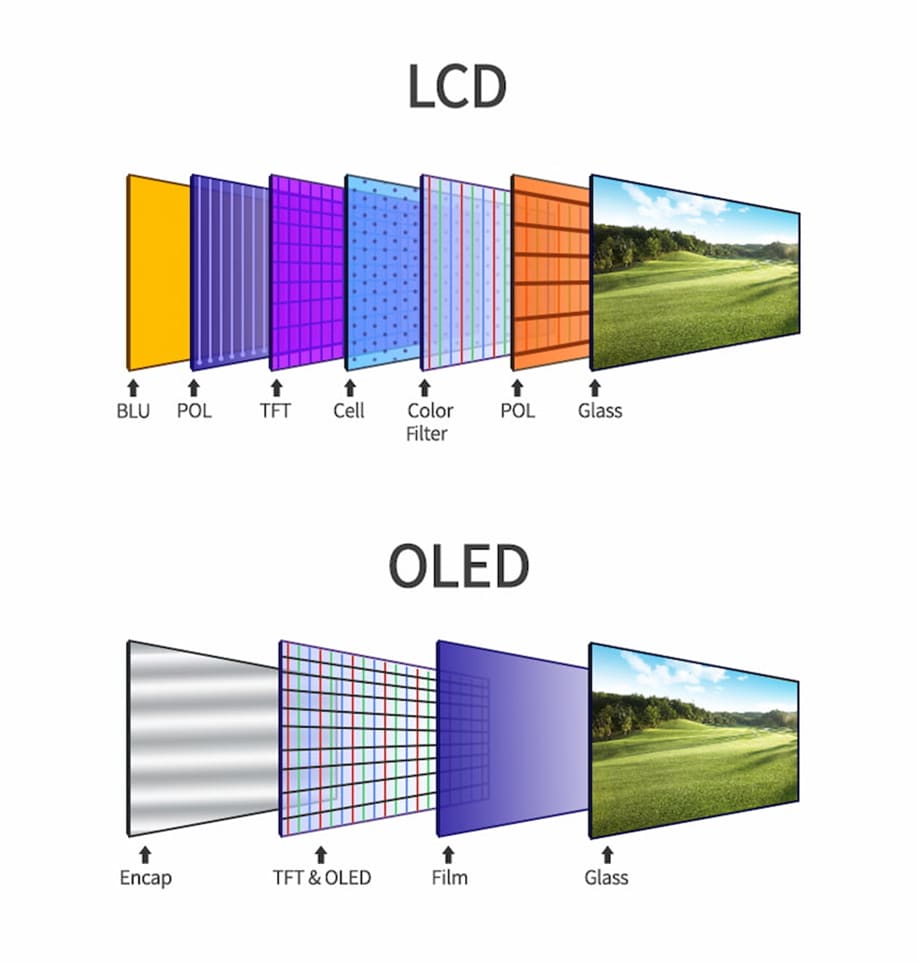
The LCD structure consists of multiple critical layers:
Backlight Assembly: Modern LCD displays utilize LED edge-lighting or direct-lit arrays to provide uniform illumination across the entire panel surface. This backlight system operates continuously, regardless of the displayed content, which has significant implications for power consumption and design flexibility.
Liquid Crystal Layer: The heart of LCD technology lies in the liquid crystal material, which changes its molecular orientation when subjected to electric fields. This property allows precise control over light transmission on a per-pixel basis, creating the foundation for image formation.
Color Filter Array: Red, green, and blue color filters are precisely aligned with individual subpixels to produce the full spectrum of colors visible to the human eye. The quality and precision of these filters directly impact color accuracy and gamut coverage.
Polarizing Films: Multiple polarizing layers work in conjunction with the liquid crystal material to control light transmission effectively, ensuring proper contrast and preventing light leakage.
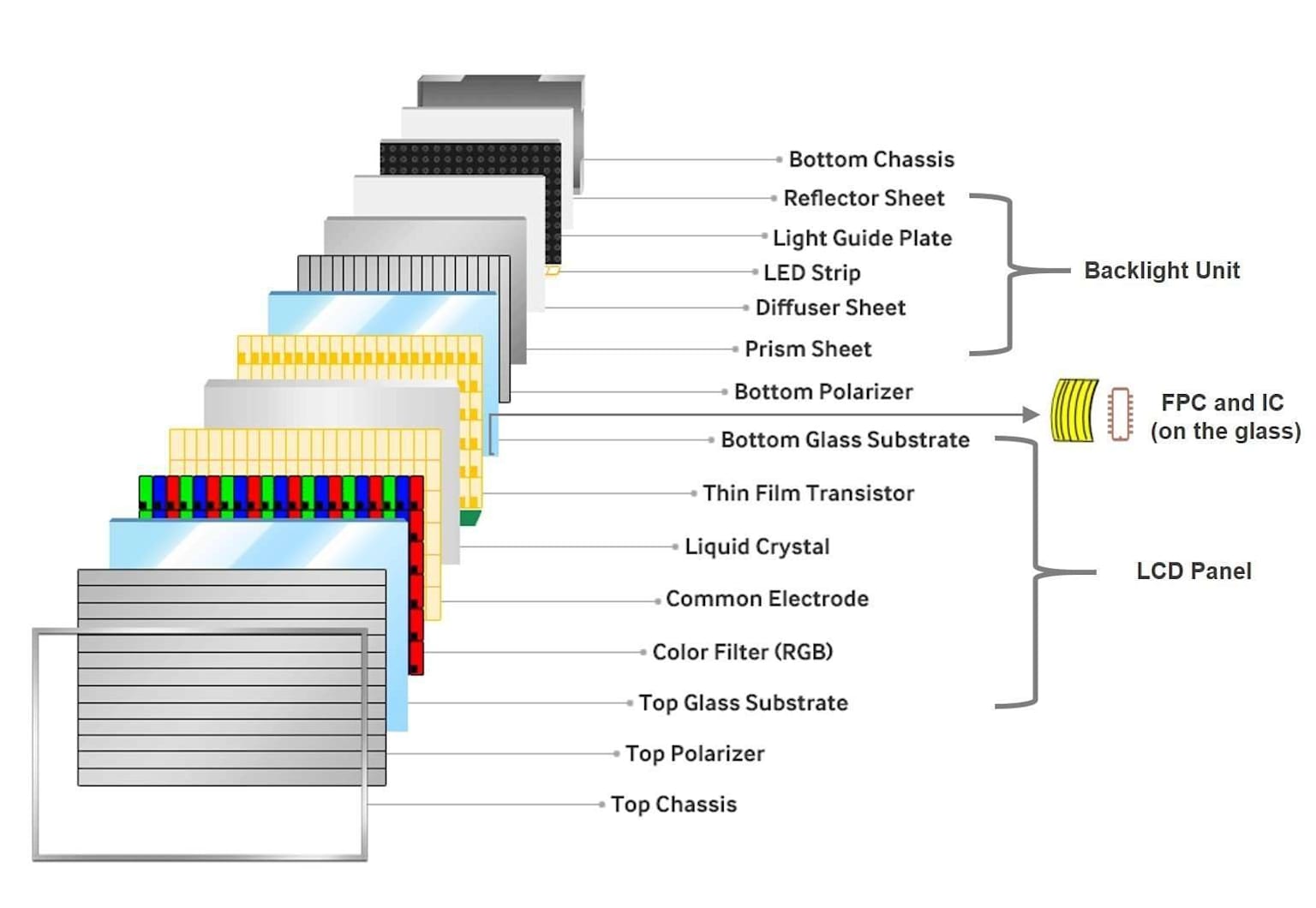
This multi-layer architecture, while enabling reliable and cost-effective manufacturing, inherently limits the minimum achievable thickness and restricts design flexibility. The requirement for continuous backlighting also impacts power efficiency and prevents true black reproduction, as some light inevitably leaks through even when pixels are intended to display black.
OLED: Self-Emitting Pixel Technology
OLED technology represents a paradigm shift in display design, eliminating the need for separate backlighting systems through the use of organic light-emitting diodes that generate light directly when electrical current is applied. Each individual pixel contains organic compounds that emit light in specific wavelengths, creating a fundamentally different approach to image generation.
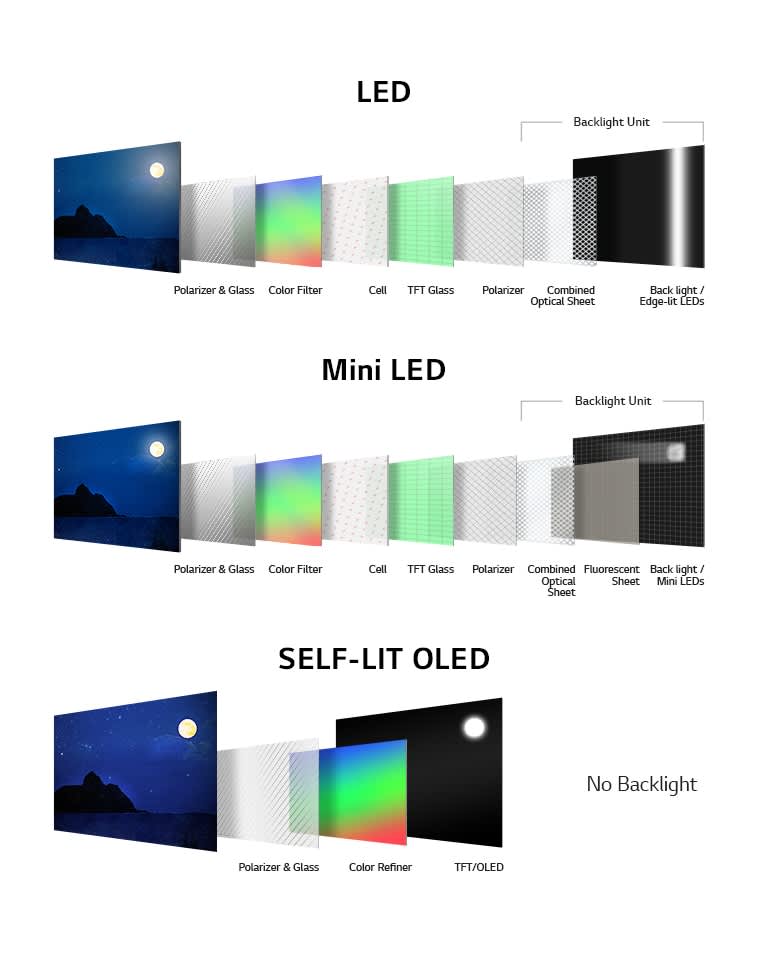
The OLED architecture offers several revolutionary advantages:
Individual Pixel Control: Each pixel can be independently turned on, off, or dimmed to any level, enabling perfect black reproduction and infinite contrast ratios. This capability fundamentally changes the visual experience, particularly for HDR content and dark scene reproduction.
Ultra-Thin Profile: Without the need for backlight assemblies, OLED panels can achieve remarkable thinness, with some implementations reaching as little as 0.3mm. This enables new form factors and design possibilities previously impossible with LCD technology.
Flexible Form Factors: The absence of rigid backlight structures allows OLED panels to be manufactured on flexible substrates, enabling curved, foldable, and even rollable display implementations.
Instantaneous Response: OLED pixels can change states virtually instantaneously, achieving response times as low as 0.1ms compared to the 4-8ms typical of LCD panels.
Subpixel Arrangements and Their Impact
The arrangement of subpixels significantly impacts display quality, manufacturing efficiency, and longevity. Understanding these arrangements is crucial for evaluating display performance and making informed purchasing decisions.
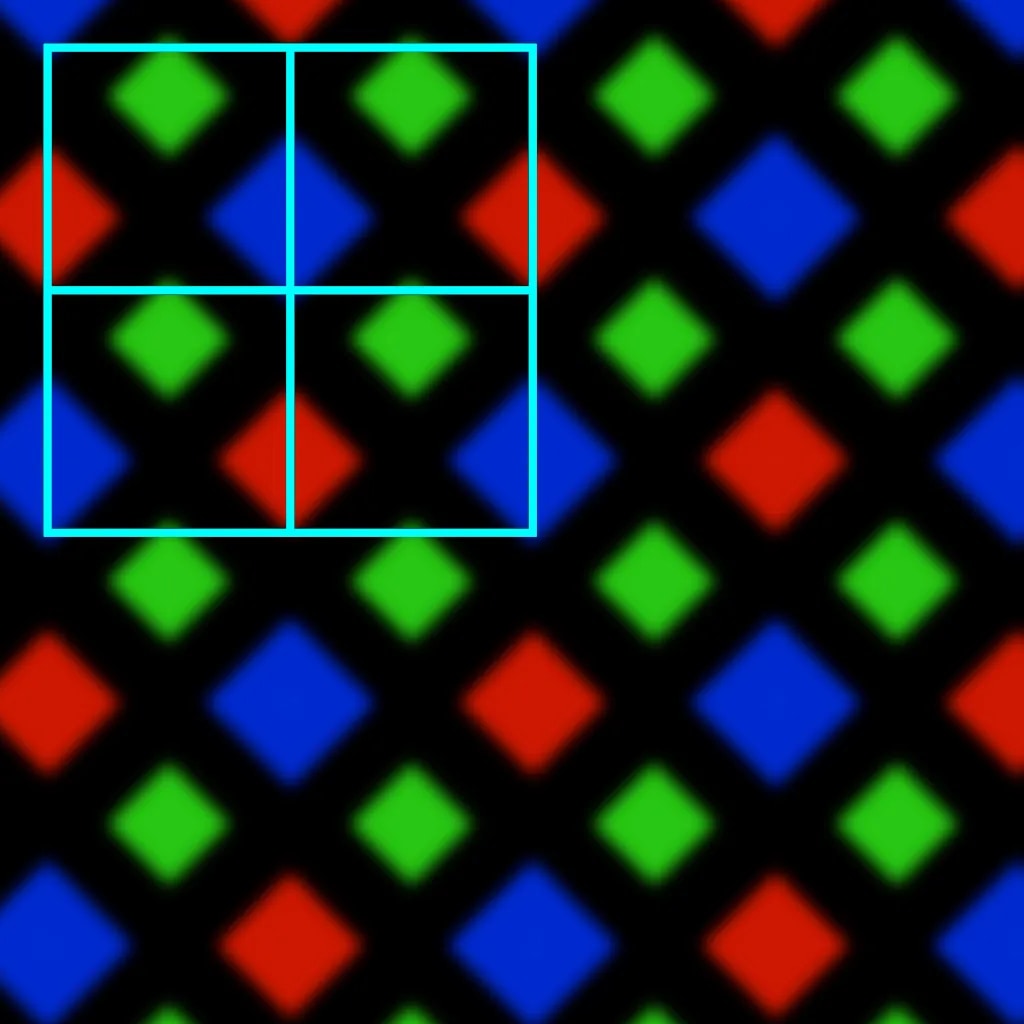
LCD RGB Stripe: Traditional LCD displays typically employ RGB stripe arrangements where each pixel consists of equally-sized red, green, and blue subpixels arranged in vertical stripes. This configuration provides excellent sharpness and color accuracy but requires precise manufacturing tolerances.
OLED PenTile RGBG: Many high-resolution OLED displays utilize PenTile arrangements with additional green subpixels to compensate for the shorter lifespan of blue organic compounds. While this approach improves longevity and manufacturing yields, it can create slight text rendering artifacts at lower resolutions.
The choice of subpixel arrangement represents a careful balance between manufacturing efficiency, display longevity, power consumption, and visual quality, with each approach offering distinct advantages for specific applications.
Core Optical Performance Parameters
Contrast Ratio and Black Level Performance
Contrast ratio represents one of the most significant differentiators between OLED and LCD technologies, with implications extending far beyond simple specifications to fundamental viewing experience quality.
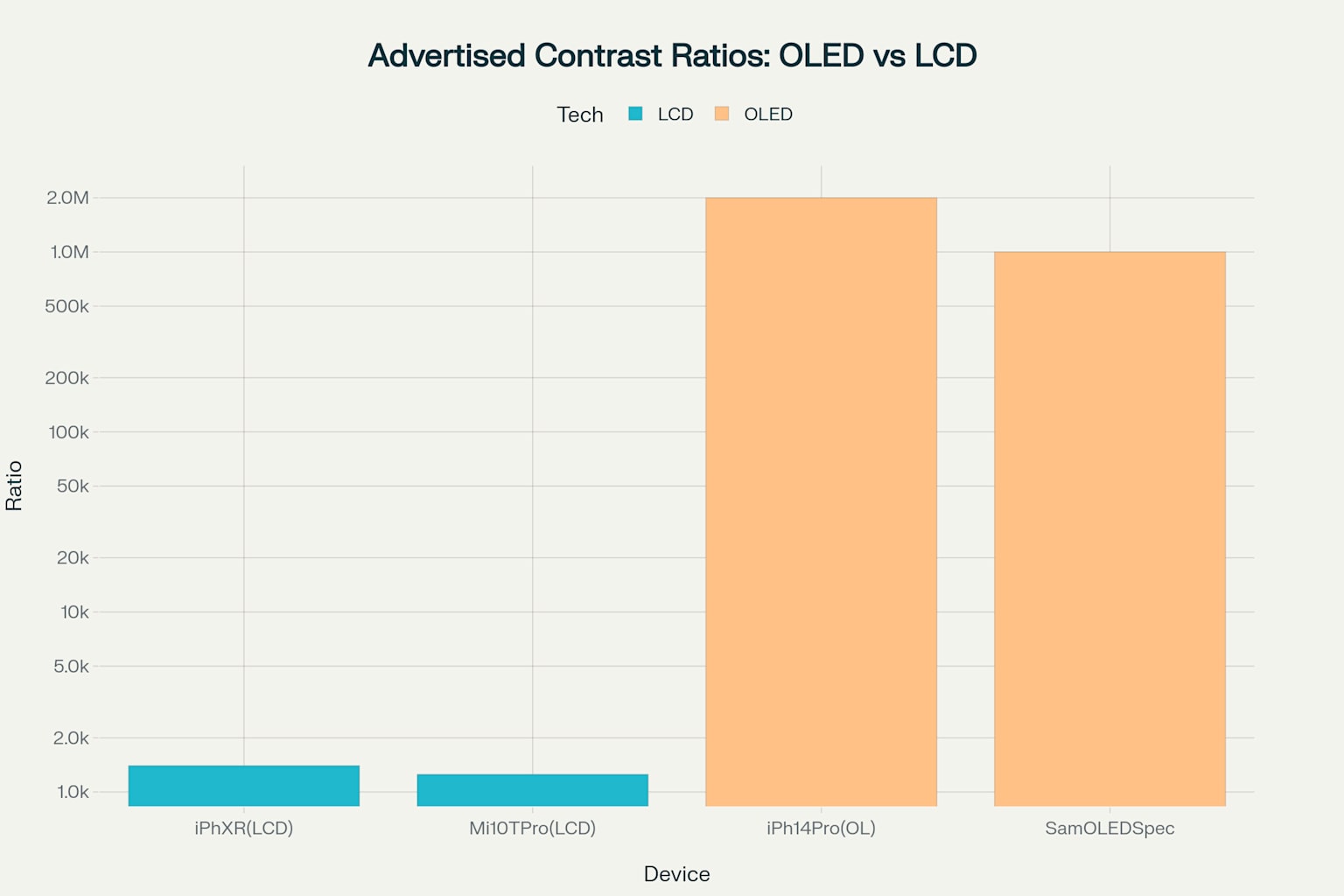
LCD Contrast Limitations: Even the highest-quality LCD panels struggle with black level reproduction due to backlight leakage. Premium IPS LCD displays typically achieve contrast ratios between 1,200:1 and 1,600:1, with specific examples including:
- iPhone XR: 1,400:1 contrast ratio
- Xiaomi Mi 10T Pro: 1,252:1 contrast ratio
This limitation becomes particularly noticeable in dark viewing environments where the inability to achieve true black creates a grayish appearance that reduces immersion and detail visibility in shadow areas.
OLED Contrast Superiority: OLED technology's ability to completely turn off individual pixels enables theoretically infinite contrast ratios, with manufacturers commonly claiming ratios exceeding 1,000,000:1. Real-world examples include:
- Samsung Galaxy displays: 1,000,000:1 advertised contrast
- iPhone 14 Pro: 2,000,000:1 contrast ratio
This dramatic difference in contrast capability translates to superior HDR performance, better detail visibility in dark scenes, and more immersive viewing experiences, particularly for video content and gaming applications.
Brightness Capabilities and HDR Performance
Brightness performance varies significantly between LCD and OLED technologies, with each offering distinct advantages depending on usage scenarios and content types.
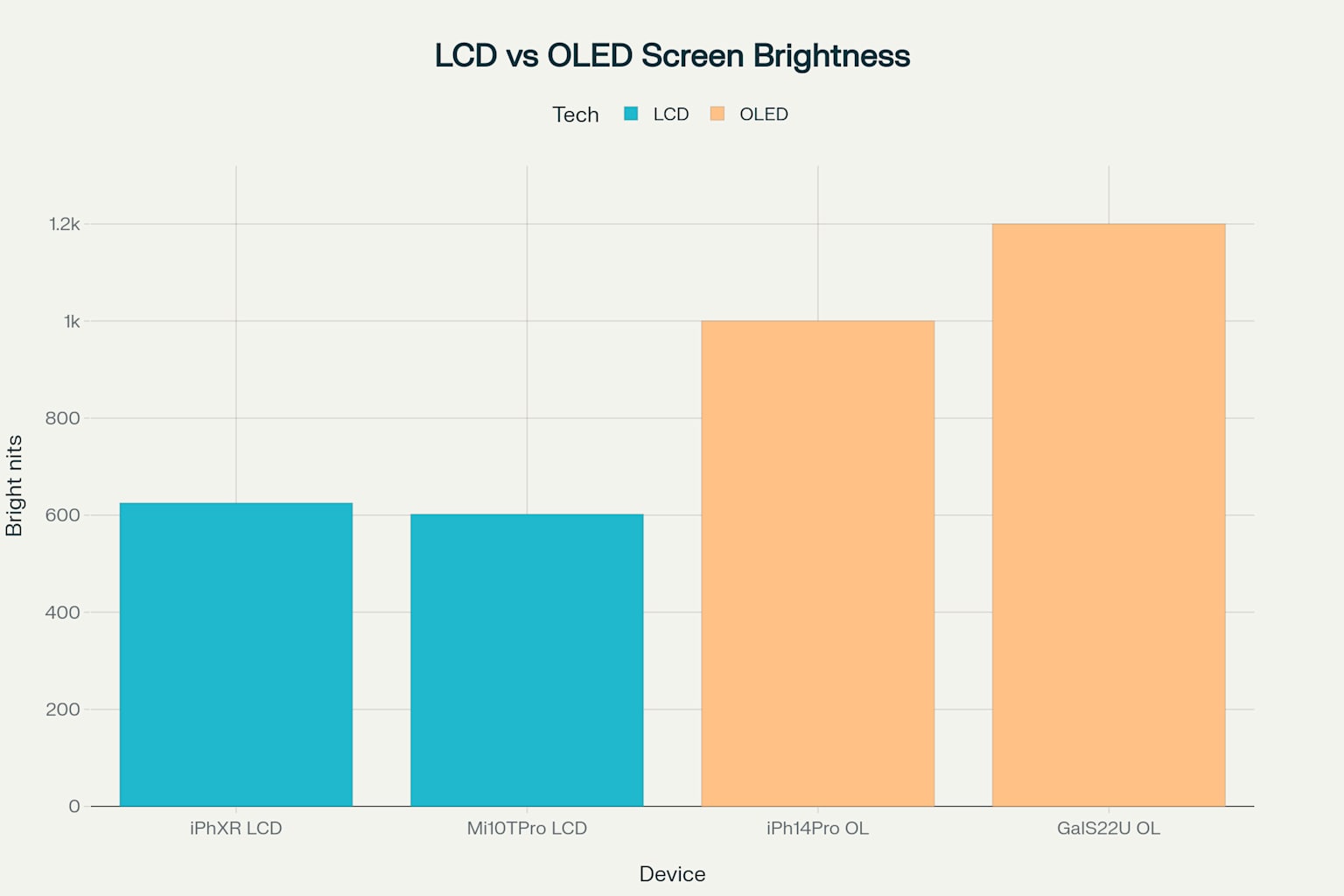
LCD Brightness Characteristics:
- Typical full-white brightness: 600-650 nits
- Peak brightness (small areas): Generally under 900 nits
- Consistent brightness across all content types
- Better sustained brightness for extended periods
Examples of LCD brightness performance:
- iPhone XR: 625 nits typical brightness
- Xiaomi Mi 10T Pro: 602 nits typical brightness
OLED Brightness Advantages:
- Typical brightness: 1,000-1,200 nits
- Peak brightness (HDR highlights): 1,750-2,300 nits
- Content-dependent brightness optimization
- Superior HDR highlight reproduction
Notable OLED brightness achievements:
- iPhone 14 Pro: 1,000 nits typical, 2,300 nits peak HDR brightness
- Samsung Galaxy S22 Ultra: 1,200 nits typical, 1,750 nits peak brightness
The higher peak brightness capabilities of OLED displays enable superior HDR content reproduction, with bright highlights appearing more realistic and impactful. However, this advantage comes with increased power consumption for bright content.
Color Gamut and Accuracy
Color reproduction capabilities significantly impact the visual experience, with both technologies offering distinct approaches to color management and gamut coverage.
LCD Color Characteristics:
- sRGB coverage: Typically 100%
- DCI-P3 coverage: Approximately 90%
- More natural, conservative color reproduction
- Consistent color accuracy across brightness levels
- Better suited for professional color-critical work
OLED Color Capabilities:
- DCI-P3 coverage: Often exceeding 120%
- Wider color gamut enables more saturated colors
- Potential for over-saturation in some implementations
- Color accuracy can vary with brightness levels
- Excellent for media consumption and gaming
The choice between these approaches depends on user preferences and intended applications. LCD's more conservative approach suits professional applications, while OLED's wider gamut provides more visually striking results for entertainment content.
Response Time and Motion Handling
Response time performance directly impacts motion clarity and gaming experience, representing another area where OLED technology demonstrates clear advantages.
LCD Response Characteristics:
- Typical gray-to-gray response time: 4-8ms
- Potential for motion blur in fast-moving content
- Overdrive techniques can improve response but may introduce artifacts
- Generally acceptable for most applications
OLED Response Superiority:
- Gray-to-gray response time: Approximately 0.1ms
- Virtually instantaneous pixel state changes
- Excellent motion clarity for gaming and sports content
- No motion blur artifacts
This dramatic difference in response time makes OLED displays particularly attractive for gaming applications and fast-motion video content, where motion clarity significantly impacts user experience.
Viewing Angles and Consistency
Viewing angle performance affects usability in various lighting conditions and viewing positions, with both technologies offering good but different characteristics.
LCD Viewing Angles:
- IPS technology: Approximately 178° viewing angles
- Minimal color shift at extreme angles
- Slight brightness reduction at off-angles
- Consistent performance across different viewing positions
OLED Viewing Angles:
- Near 180° viewing angles
- Minimal brightness and color shift
- Excellent consistency across viewing positions
- Superior performance in group viewing scenarios
Both technologies provide excellent viewing angle performance, with OLED holding a slight advantage in maintaining brightness and color accuracy at extreme viewing angles.
Power Consumption and Battery Life
Content-Dependent Power Characteristics
Power consumption patterns differ dramatically between LCD and OLED technologies, with significant implications for battery life and thermal management.
OLED Power Behavior: OLED displays exhibit highly content-dependent power consumption patterns that can significantly impact battery life depending on usage patterns:
-
Dark Content Advantage: When displaying black or very dark content, OLED pixels can be completely turned off, resulting in zero power consumption for those areas. This creates substantial power savings for dark user interfaces, night modes, and content with significant black areas.
-
Bright Content Challenge: Large areas of bright white or colorful content require all pixels to operate at high brightness levels, resulting in power consumption that can exceed LCD displays. This is particularly noticeable with white backgrounds, web browsing, and productivity applications.
-
Mixed Content Optimization: Real-world content typically contains a mixture of bright and dark elements, allowing OLED displays to optimize power consumption dynamically based on the specific content being displayed.
LCD Power Consistency: LCD displays maintain relatively consistent power consumption regardless of displayed content:
-
Backlight Constant Operation: The LED backlight operates continuously at a consistent level, regardless of whether the screen displays black, white, or colored content.
-
Predictable Power Draw: This consistency makes battery life more predictable and easier to optimize for specific usage patterns.
-
White Content Efficiency: LCD displays are generally more power-efficient when displaying predominantly white or bright content, making them well-suited for productivity applications and web browsing.
LTPO Technology and Variable Refresh Rates
Low-Temperature Polycrystalline Oxide (LTPO) technology represents a significant advancement in OLED display efficiency, enabling dynamic refresh rate adjustment based on content requirements.
LTPO Benefits:
- Variable refresh rates from 1Hz to 120Hz
- 5-15% reduction in overall panel power consumption
- Improved battery life for static content
- Enhanced always-on display capabilities
- Better optimization for different content types
Implementation Examples:
- Static content (reading, always-on display): 1-10Hz
- Standard UI interactions: 60Hz
- Gaming and high-motion content: 120Hz
- Video content: Matched to source frame rate
This technology allows OLED displays to achieve better power efficiency while maintaining excellent performance for demanding applications.
Real-World Battery Impact
The practical impact of display technology on battery life varies significantly based on usage patterns, with both technologies offering advantages in different scenarios:
OLED Battery Performance:
- Excellent for users who prefer dark themes and interfaces
- Superior for media consumption with varied content
- Potential battery drain with productivity applications
- Benefits from LTPO implementation in premium devices
LCD Battery Performance:
- Consistent performance across all usage patterns
- Better for users who primarily use bright interfaces
- Excellent for extended reading and productivity work
- Predictable battery life characteristics
Eye Comfort and Health Considerations
PWM Flicker and Its Effects
Pulse Width Modulation (PWM) flicker represents one of the most significant health-related differences between LCD and OLED technologies, with important implications for user comfort and long-term eye health.
LCD PWM Characteristics:
- High-frequency PWM: Typically above 1,000Hz
- DC dimming options available in many implementations
- Minimal flicker-related eye strain for most users
- Consistent brightness control across all levels
- Better suited for users sensitive to flicker
OLED PWM Challenges:
- Low-frequency PWM: Often 240-480Hz at low brightness levels
- Potential for eye strain, headaches, and fatigue in sensitive individuals
- More noticeable flicker in peripheral vision
- Varies significantly between manufacturers and models
Mitigation Strategies: Manufacturers are implementing various approaches to address OLED PWM concerns:
- High-frequency PWM solutions (>1,440Hz)
- DC dimming implementations
- Hybrid dimming approaches
- User-selectable dimming modes
Blue Light Emission Patterns
Blue light emission characteristics differ significantly between LCD and OLED technologies, with implications for circadian rhythm regulation and eye comfort.
LCD Blue Light Profile:
- Higher concentration of harmful short-wavelength blue light
- Peak emission around 450nm
- Consistent blue light output from LED backlights
- May require software or hardware filtering
OLED Blue Light Advantages:
- Approximately 70% less harmful blue light compared to LCD
- Peak emission above 460nm
- More natural light spectrum
- Reduced impact on sleep patterns
- Less need for blue light filtering
Long-Term Eye Health Impact
The long-term health implications of different display technologies are becoming increasingly important as screen usage continues to increase across all demographics.
Factors Affecting Eye Health:
- Flicker frequency and amplitude
- Blue light exposure levels
- Brightness consistency
- Viewing distance and duration
- Individual sensitivity variations
Professional Recommendations:
- Choose displays with high-frequency PWM or DC dimming
- Utilize dark modes when available with OLED displays
- Implement regular viewing breaks regardless of technology
- Consider individual sensitivity to flicker and blue light
- Adjust brightness levels appropriately for ambient conditions
Design, Durability, and Cost Analysis
Thickness and Form Factor Possibilities
The structural differences between LCD and OLED technologies create dramatically different possibilities for device design and form factor innovation.
LCD Design Constraints:
- Minimum thickness typically exceeds 3mm due to backlight requirements
- Rigid structure limits design flexibility
- Rectangular form factors predominate
- Limited curve radius capabilities
- Established manufacturing processes enable cost optimization
OLED Design Advantages:
- Ultra-thin profiles achievable (as low as 0.3mm)
- Flexible substrate compatibility
- Curved, foldable, and rollable implementations possible
- Innovative form factors enable new product categories
- Premium positioning supports higher manufacturing costs
Emerging Form Factors:
- Foldable smartphones with OLED displays
- Curved edge implementations
- Rollable display concepts
- Wearable device integration
- Automotive dashboard applications
Lifespan and Degradation Patterns
Longevity characteristics represent a crucial consideration for both consumers and repair professionals, with significant differences between technologies.
LCD Lifespan Advantages:
- Typical lifespan: 40,000-60,000 hours at 50% brightness
- Consistent performance throughout operational life
- No burn-in susceptibility
- Gradual, uniform degradation patterns
- Excellent long-term reliability
OLED Lifespan Challenges:
- Typical lifespan: 8,000-30,000 hours at 50% brightness
- Blue pixel degradation occurs faster than red and green
- Potential for burn-in with static content
- Uneven degradation can cause color shifts
- Improving but still shorter than LCD technology
Degradation Mitigation: Modern OLED displays incorporate various technologies to extend lifespan:
- Pixel shifting algorithms
- Brightness limiting for static elements
- Improved organic compounds
- Better encapsulation techniques
- Software-based burn-in prevention
Manufacturing and Repair Costs
Cost considerations significantly impact market positioning and repair economics, with important implications for both manufacturers and service providers.
LCD Cost Structure:
- Mature manufacturing processes
- Established supply chains
- Component-level repair possibilities
- Lower replacement part costs
- Better suited for budget market segments
OLED Cost Factors:
- 6-inch QHD rigid OLED: Approximately 20% higher cost than equivalent LCD
- Flexible OLED: Additional 20-30% premium over rigid implementations
- Complex manufacturing processes
- Higher yield loss rates
- Full panel replacement typically required for repairs
Repair Implications:
- LCD: Individual component replacement possible (backlight, LCD layer)
- OLED: Complete panel replacement usually necessary
- OLED repair costs significantly higher
- LCD better suited for cost-conscious repair scenarios
- OLED repairs often approach device replacement costs
Market Trends and Future Outlook
Current Market Positioning
The display technology landscape continues to evolve rapidly, with clear segmentation emerging based on device positioning and target markets.
Premium Segment Dominance:
- Flagship smartphones almost universally adopt OLED technology
- LTPO implementation becoming standard in high-end devices
- Under-display fingerprint sensors require OLED technology
- Always-on display features leverage OLED power efficiency
Mid-Range Market Evolution:
- OLED adoption expanding into mid-range price points
- LCD maintaining presence in cost-sensitive segments
- Gaming-focused devices sometimes prefer high-refresh LCD
- Regional preferences affecting technology adoption rates
Budget Segment Persistence:
- LCD technology continues to dominate entry-level devices
- Cost advantages remain significant for price-sensitive markets
- Mature manufacturing enables aggressive pricing
- Adequate performance for basic smartphone functions
Emerging Technologies and Improvements
Both LCD and OLED technologies continue to evolve, with significant improvements addressing current limitations.
OLED Advancements:
- QD-OLED technology improving efficiency and lifespan
- Blue phosphorescent materials extending blue pixel life
- High-frequency PWM becoming more common
- Improved manufacturing yields reducing costs
- Micro-OLED for specialized applications
LCD Innovations:
- Mini-LED backlighting improving contrast ratios
- Quantum dot enhancement expanding color gamuts
- Higher refresh rates for gaming applications
- Improved viewing angles and response times
- Continued cost optimization
Next-Generation Technologies:
- MicroLED displays combining OLED and LCD advantages
- E-ink color displays for specific applications
- Holographic and 3D display technologies
- Transparent display implementations
- Integration with augmented reality systems
Industry Predictions
Market analysis suggests continued evolution in display technology adoption patterns over the next five years.
Short-Term Trends (1-2 years):
- OLED market share expansion in mid-range segments
- LCD retreat to budget and specialized applications
- Foldable device market growth driving flexible OLED demand
- Improved OLED longevity and reduced costs
Medium-Term Outlook (3-5 years):
- OLED becoming dominant across most price segments
- LCD maintaining niches in gaming, outdoor, and budget markets
- MicroLED technology beginning commercial deployment
- Significant improvements in OLED eye comfort features
Long-Term Vision (5+ years):
- MicroLED potentially disrupting both OLED and LCD markets
- Specialized display technologies for specific applications
- Integration with emerging computing paradigms
- Sustainable manufacturing becoming increasingly important
Professional Recommendations
Use Case Scenarios
Selecting the appropriate display technology requires careful consideration of specific use cases, user preferences, and operational requirements.
Choose OLED Technology For:
Premium Media Consumption:
- Superior HDR content reproduction
- Excellent contrast for movie watching
- Vibrant colors for gaming and entertainment
- Dark room viewing optimization
Design-Forward Applications:
- Thin and light device requirements
- Curved or flexible form factors
- Premium aesthetic considerations
- Innovative product differentiation
Power-Conscious Dark Theme Users:
- Extensive use of dark interfaces
- Always-on display requirements
- Mixed content consumption patterns
- LTPO-enabled variable refresh rate benefits
Choose LCD Technology For:
Professional and Productivity Applications:
- Color-critical work requirements
- Extended reading and document work
- Bright environment usage
- Consistent brightness needs
Budget-Conscious Implementations:
- Cost-sensitive market segments
- Repair cost considerations
- Long-term durability requirements
- Predictable performance characteristics
Specialized Applications:
- Gaming with high refresh rate priorities
- Outdoor and high-brightness environments
- Industrial and commercial applications
- Eye comfort for sensitive users
Selection Criteria
Professional evaluation of display technologies should consider multiple factors beyond basic specifications.
Technical Performance Priorities:
- Contrast ratio requirements for intended content
- Brightness needs for typical usage environments
- Color accuracy requirements for specific applications
- Response time importance for gaming or motion content
- Power consumption impact on battery life
User Experience Factors:
- Eye comfort and flicker sensitivity
- Viewing angle requirements
- Form factor and design preferences
- Longevity and durability expectations
- Repair and maintenance considerations
Economic Considerations:
- Initial device cost implications
- Long-term ownership costs
- Repair and replacement expenses
- Market positioning requirements
- Technology lifecycle expectations
Future-Proofing Considerations
Technology selection should account for evolving standards and future requirements.
OLED Future-Proofing Advantages:
- Continued improvement in lifespan and efficiency
- Growing software optimization for OLED characteristics
- Expanding availability across price segments
- Innovation in form factors and applications
- Industry momentum toward OLED adoption
LCD Future-Proofing Considerations:
- Mature technology with predictable evolution
- Continued cost advantages in specific segments
- Specialized applications maintaining LCD preference
- Established repair and service infrastructure
- Potential for disruptive improvements (Mini-LED, Quantum Dot)
Technology Transition Planning:
- Evaluate current and projected usage patterns
- Consider user adaptation to new technologies
- Plan for changing market availability
- Account for evolving content and application requirements
- Prepare for next-generation technology adoption
Conclusion
The choice between OLED and LCD display technologies represents a complex decision involving technical performance, user experience, economic factors, and future considerations. Both technologies offer distinct advantages that make them suitable for different applications and user requirements.
OLED technology excels in contrast ratio, design flexibility, HDR performance, and innovative form factors, making it ideal for premium devices, media consumption, and applications where visual impact is paramount. However, considerations around longevity, PWM flicker, and cost must be carefully evaluated.
LCD technology provides excellent value, consistent performance, eye comfort advantages, and proven reliability, making it well-suited for professional applications, budget-conscious implementations, and users who prioritize long-term durability and predictable costs.
As both technologies continue to evolve, the gap between them narrows in some areas while widening in others. OLED's rapid advancement in manufacturing efficiency and performance improvements suggests continued market share growth, while LCD's established advantages ensure its continued relevance in specific market segments.
For repair professionals and industry stakeholders, understanding these technologies' characteristics, limitations, and trends is essential for making informed recommendations and business decisions. The future likely holds room for both technologies, each serving distinct market needs and user preferences.
The ultimate choice should be based on careful evaluation of specific requirements, usage patterns, budget constraints, and long-term expectations, rather than following general market trends or specifications alone.
PRSPARES offers comprehensive display solutions for both OLED and LCD technologies, providing repair professionals with access to premium quality replacement parts, technical support, and industry expertise. Contact our team for personalized recommendations based on your specific requirements and market positioning.


